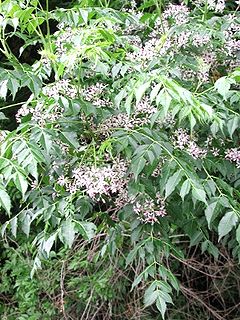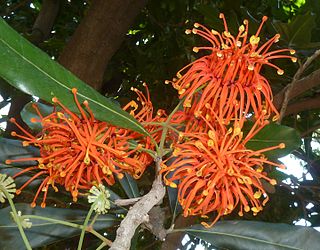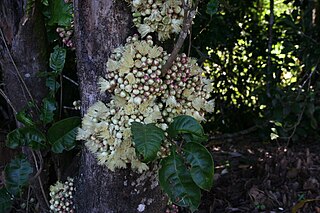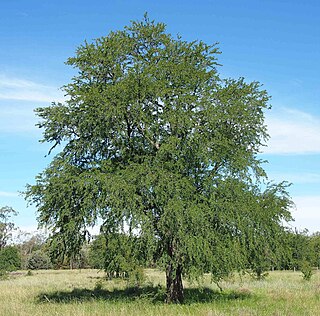
Meliaceae, the mahogany family, is a flowering plant family of mostly trees and shrubs in the order Sapindales.

Eupomatia laurina, commonly named bolwarra, native guava or copper laurel, is a species of plant in the primitive flowering-plant family Eupomatiaceae, endemic to Australia and New Guinea. It grows to between 3 and 5 m tall, but larger specimens may attain a height of 15 m (50 ft) and a trunk diameter of 30 cm (12 in). In Australia, it is found in humid forests of the east coast, from as far south as Nowa Nowa in Victoria, north through New South Wales and Queensland to tropical Cape York Peninsula. It usually grows as an understorey plant in rainforests or humid Eucalypt forests.

Angophora hispida grows as a mallee, or as a tree to about 7 m (25 ft) in height. A. hispida's small size, especially when compared to its Angophora and Eucalyptus relatives, leads to it being known by the common name dwarf apple. It is native to a relatively small patch of central New South Wales – from just south of Sydney up to the Gosford area. The plant's leaves are sessile (stalk-less) and hug the stem with heart-shaped bases. Its previous name – A. cordifolia – referred to these cordate leaves. Another distinctive feature are the red bristly hairs that cover the branchlets, flower bases and new growth. This leads to the specific epithet hispida.

Atherosperma moschatum, the southern sassafras or blackheart sassafras, is an evergreen tree native to the cool temperate rainforests of Tasmania, Victoria, and New South Wales in Australia. It is common in the rainforests of Tasmania and Victoria, but more scattered and rare in the higher altitudes of eastern New South Wales. The northernmost area is at Mount Grundy, west of Port Macquarie.

Pouteria australis, also known by the synonym Planchonella australis, is a medium to tall rainforest tree of the family Sapotaceae native to Queensland and New South Wales, Australia. It is known by the common name black apple, wild plum, yellow buttonwood, black plum and yellow bulletwood.

Litsea reticulata is a common Australian tree, growing from near Milton, New South Wales to the Bunya Mountains, Queensland. Common names include bollygum, bolly wood and brown beech. The habitat of the bollygum is rainforest of most types, except the dryer forms.

Stenocarpus sinuatus, known as the firewheel tree, is an Australian rainforest tree in the family Proteaceae. The range of natural distribution is in various rainforest types from the Nambucca River in New South Wales to the Atherton Tableland in tropical Queensland. Stenocarpus sinuatus is widely planted as an ornamental tree in other parts of Australia and in different parts of the world.

Xanthostemon chrysanthus, the golden penda or first love, is a species of tree in the myrtle family Myrtaceae, endemic to north eastern Queensland, Australia. It is a popular garden plant with showy yellow blooms.

Pseudoweinmannia lachnocarpa is a rainforest tree of eastern Australia. Common names include rose marara, mararie, scrub rosewood and red carabeen. The species name lachnocarpa is from the Greek, referring to the "woolly fruit". The genus name refers to the similarity of another genus, Weinmannia, after the German eighteenth century pharmacist J.W. Weinmann.

Decaspermum humile, commonly known as the silky myrtle, is a tree from Australia and Asia. It can be used as bush food, as indicated by the alternate common name of currant myrtle. The tree features an attractive dark glossy crown. The new pink leaves with silvery hairs are particularly appealing.

Litsea bindoniana, known as the big-leaved bollywood is a rainforest tree in the laurel family. A small to medium-sized bushy tree endemic to the rainforests of tropical Queensland, Australia. It features large leaves with attractive yellow venation, 25 cm (10 in) long by 10 cm (4 in) wide. They are dark green above, and paler and somewhat hairy below. The leaf stalks are hairy. The small greenish flowers are fragrant and occur from March to May. They are followed by fruits which mature from September to October, being a black drupe. Regeneration is from fresh seed, after removing the fleshy aril around the seed.

Planchonella queenslandica, the blush condoo, is a large rainforest tree of the family Sapotaceae native to eastern Australia. It is found in sea side rainforest as well as the drier inland rainforests. From as far south as the Richmond River, New South Wales to Coen in tropical Queensland, and as far west as Melville Island, Northern Territory.

Gmelina fasciculiflora, known as the northern white beech is a species of trees endemic to the Queensland tropical rain forests, Australia, of the mint (Lamiaceae) plant family. It is one of four recognised species of the genus Gmelina found in Australia.

Alectryon tomentosus, commonly known as the hairy birds eye, red jacket or woolly rambutan, is a rainforest tree of the family Sapindaceae found in eastern Australia. The specific epithet tomentosus refers to the hairy leaves and hairy young shoots.

Pouteria eerwah is a rare species of Australian rainforest tree in the family Sapotaceae. Common names include shiny-leaved condoo, black plum and wild apple. It is endemic to south eastern Queensland, with a restricted distribution and regarded as endangered. There is discussion whether this plant should remain named as Planchonella eerwah.

Dysoxylum pettigrewianum, commonly known as spur mahogany, spurwood, or Cairns satinwood is a species of large tropical rainforest tree in the family Meliaceae found in Queensland, New Guinea, Solomon Islands and Malesia. In Queensland it is found in the wet tropics from Rossville near Cooktown in the north, southwards to Tully.

Syzygium cormiflorum, commonly known as the bumpy satinash, is a species of Syzygium tree endemic to Queensland in northeastern Australia.

Syzygium fullagarii, commonly known as the scalybark, is a relatively large tree in the Myrtle family. It is found only on Lord Howe Island. It grows to 20 metres tall, up to an altitude of 400 metres above sea level in sheltered areas, often in rainforest. The bark is reddish brown, usually flaking to the touch. The base of the tree is often heavily buttressed. Known for many years as Cleistocalyx fullagarii, however, in recent times it has been placed in the large genus Syzygium.

Lysiphyllum hookeri is a species of small tree endemic to Queensland, Australia, of the legume plant family Fabaceae. These trees are known by a variety of common names, including pegunny, alibangbang, Hooker's bauhinia, white bauhinia, mountain ebony and Queensland ebony.

Lomatia tinctoria, commonly known as guitar plant, is a shrub to about 2 metres tall of the family Proteaceae. It is one of three species of Lomatia endemic to Tasmania, the others being L. polymorpha and L. tasmanica. Lomatia tinctoria is closely related to L. polymorpha, with which it sometimes hybridises. Its leaves are divided, while those of L. polymorpha are simple.


























